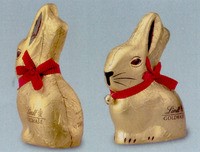
Part 1A: The Golden Hare and Monochromic affair
On the day of July 29, 2021, the folks at Lindt & Sprüngli Group rejoiced, for Easter (bunnies) had been saved. Said statement was a reference to the decision by the German Federal Court of Justice (BGH) wherein it was decided that the “gold colour” foil used to wrap chocolate Easter bunnies made by the Swiss Chocolate maker Lindt & Sprüngli Group was entitled to trademark protection. The illustration of the bunny is as below.

To briefly summarize the context, the dispute before the BGH was an appeal on trademark infringement by a competitor, German company Heilemann. This company marketed chocolate bunnies, a famous dessert, especially around Easter, in a golden colour similar to that of the Lindt Gold Bunny. In 2018, Lindt became aware of the competitor’s practice and its misuse and brought an action before the District Court, Munich. It relied on unregistered trademark rights existing in the gold coloured foil by means of use (flowing from Section 4(2) of the German Trademark Act) rather than registered trademark rights. Section 4 of the German Trademark Act provides for accrual of trademark protection and clause (2) states that ‘use of a sign in trade in so far as the sign has acquired public recognition as a trademark within the affected trade circles; would give rise to trademark protection’.
The District Court, Munich ruled in favour of Lindt upholding their unregistered trademark rights in the gold colour of foil, relying on public perception of the colour indicating origin and attributable distinctiveness owing to use and advertising over the years. However, this decision was appealed before the Higher Regional Court of Munich that overturned the decision of the District Court and observed that “abstract colour marks cannot be protected as trademarks under section 4(2) but as usage marks, provided they have achieved enough traffic”. The Higher Regional Court was of the view that the golden colour had not acquired the requisite reputation to entitle it protection as the colour was not used as their “house mark” for a large variety of goods but only for a particular chocolate bunny. The BCG, however, held that the plaintiffs had obtained sufficient market recognition. Further, it was not necessary for the traffic to be based on the colour being the house colour or be used on all of the company’s products and the appeal with respect to trademark infringement was sent back to the Higher Regional Court. What is interesting to note is that the court acknowledged the other design element in the Lindt Gold Bunny such as seated bunny, red collar with a golden bell and the inscription ‘Lindt Gold Bunny’, but the additional design elements do not inhibit the use of golden colour as a mark. In other words, the colour does work as an indication of origin for the relevant public, even when combined with the other design elements. The strategy adopted by the counsels was rather unconventional considering how Lindt has trademark registrations for both the golden shape of the bunny (under Registration No. 30642479) and the illustration above (under Registration No. 30642480) in Germany. What adds on to the confusion in this instance is the ruling of the Court of Justice of the European Union (CJEU) from 2012, wherein it was held that the trademark for the shape and get up of the gold bunny lacked distinctiveness.
Global gradient: the international position of colour
The arguments against allowing such trademark registration are that single colour marks are difficult to describe or to satisfy the graphical representation requirement and lack distinctiveness to be recognized as a trademark. Additionally, grant of single colour trademarks in favour of a proprietor might endanger the competitor’s choice of attractive colour schemes, since the spectrum of colours is not infinite. The registrability of single colour trademarks, while not explicitly recognized, can be interpret using Article 15: Protectable Subject Matter (of Trademarks) of the World Trade Organization (WTO) Agreement on Trade-Related Aspects of Intellectual Property Rights (TRIPS) which provides for “any sign capable of distinguishing goods/services of one undertaking from those of other” and in most cases, the sign must be visually perceptible. In instances where the sign is not inherently capable of distinguishing the relevant goods/services, registrability would depend on “distinctiveness acquired through use”. In fact, the Module on Trademarks of Guide to the TRIPS Agreement explains how the traditional concept of trademarks is broadening to include colour as “while most trademarks are word marks, graphic symbols, labels or logos, there have been registrations of … colours (such as magenta colour of Deutsche Telekom)”.
Although there are litigations wherein the validity of single colour trademarks is contested, several proprietors have been successful in obtaining registrations for the same. Popular examples of the same are Canary Yellow (Pantone 601C) owned by 3M Company for their post-its (Application No. 000655019 in the European Union), Robin’s Egg Blue (PMS 1837) in the name of Tiffany & Company for their boxes and bags (WIPO Application No. 1208903), Brown (PMS 476C) for United Parcel Service (Application No. 000962076 in the European Union) and Red (Pantone 18‑1663TP) for sole of shoes in the name of Christian Louboutin (Application No. 3414903 in France). The validity of the red coloured shoe sole as a trademark is often objected as in the case of Christian Louboutin SAS v. Van Haren Schoenen BV where the question was whether the application made clear references to the shape and the colour of the sole within one application.
Hint of Tint: what happens in Europe?
Let’s look at some cases of Europe specifically. The statutory provision of relevance, in addition to domestic legislation, is the Trade Marks Directive 2008/95/EC which under Article 2: Signs of which a trademark may consist provides that ‘A trade mark may consist of any signs capable of being represented graphically, particularly words, including personal names, designs, letters, numerals, the shape of goods or of their packaging, provided that such signs are capable of distinguishing the goods or services of one undertaking from those of other undertakings’ and under Article 3: Grounds for refusal or invalidity provides that ‘a mark can be refused registration or declared invalid when – (a) signs cannot constitute a trade mark or (b)when marks are devoid of distinctive character.’
In the landmark case of Libertel Groep BV v. Benelux-Merkenbureau, the question before the European Court of Justice (ECJ), back in 2003, was- if a single colour (in this case, the colour orange for telecommunications) could be protected as a trademark and how to graphically represent the colour on the application, for registration of the same. It was held that colours could constitute a sign, depending on the context and to fulfil the graphical representation requirement often mentioned in trademark legislations/treaties – a sample of the colour combined with description in words of that colour or designation of colour using internationally recognized identification code would be qualifiable. However, in this case, the ECJ was also of the view that granting single colour registrations would be unduly restricting the availability of colours for other traders, given that the number of colours available is limited. The criteria of the Libertel case are still referred to in Europe when single coloured marks are considered.
Given our discussions around Lindt, it would be relevant to discuss another chocolatier – Cadbury. In the case of Société Des Produits Nestlé S.A. v. Cadbury UK Limited, Cadbury’s single colour trademark application in the shade of Purple (Pantone 2685C) was challenged by its competitor, Nestlé. The Court of Appeals based their reasoning on whether the single colour marks would constitute a sign and would be graphically represented, given that they are unconventional trademarks. It was held that the application by Cadbury would not be registrable owing to the description of the mark being open to misinterpretation. The description of the mark read as ‘the colour applied to the whole visible surface or being the predominant colour applied in packaging of goods’. To elaborate, Cadbury, in one application sought to protect not just the use of its iconic purple applied totally and in an isolated manner but also for protecting packaging where this shade of purple features ‘predominantly’ and this was what troubled the court. Nestlé was successful in this appeal as allowing an application that “lacked specificity, clarity and precision of visual appearance would offend the principle of certainty and would go against the principle of fairness by putting Cadbury’s competitors at a disadvantage”. By means of this case, the court had observed that while single colour marks having acquired distinctive character are protectable as signs, they must satisfy the tests of being clear, precise, self-contained, easily accessible, intelligible, durable and objective, and that to reproduce the colour on paper is not enough, whereas reference to a suitable code may be. Subsequent to the outcome of this ruling concerning trademark application of 2004, Cadbury attempted to obtain registration over the mark by amending its description to remove the ‘prominent’ bit but the same was not successful (Cadbury v. The Comptroller General of Patents, Designs & Trademarks). Thereafter, Cadbury also decided to drop its 1995 trademark, realizing it was unenforceable and henceforth, relied on unregistered trademark rights for enforcement.

Sakshi Sharma
Author
Sakshi is a practicing Intellectual Property attorney who has worked as a litigation associate with a leading IP law firm. She has advised several national and international clients on contentious and non-contentious matters grounded in trademark, copyright, design and GI law and additionally, intersections of intellectual property law with advertising, consumer protection and information technology law. She is a graduate of Gujarat National Law University.
I read this post your post so nice and very informative post thanks for sharing this post